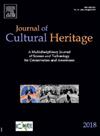浸水考古木材周围的沉积物:砷是否可能参与保护木桩住宅免受微生物腐烂?大卡罗案例研究(意大利中部博尔塞纳湖)
IF 3.3
2区 综合性期刊
0 ARCHAEOLOGY
引用次数: 0
摘要
浸水考古木材(WAW)的保护取决于与水和/或沉积物有关的几种非生物特性(温度、pH值、氧化还原电位、盐度、重金属或污染物)和生物因素(微生物的数量和类型及其代谢活性)。所有这些因素都可能被人类活动和/或气候变化所改变,从而加速或减少木材的腐烂率。无论其速率如何,水下物质的分解和变化都可以在周围的沉积物特性中留下痕迹。Gran Carro是一个考古遗址,位于Bolsena湖(意大利中部),以木桩住宅(WPD)的存在为特征。根据最新的考古证据,该遗址的历史可以追溯到青铜时代中期(公元前15世纪)到铁器时代早期(公元前9世纪)。研究涝渍水域,特别是位于地中海地区的水域,是由JPI-CH19资助的WOODPDLAKE项目的目标。本文报道了Bolsena湖沉积物的化学、生化(酶活性)和微生物特性(EL-FAME剖面),在与WAW紧密接触的部分(WSed)和周围沉积物(Sed)中进行了区分,旨在突出任何“木材效应”。大多数特性表现出明显的“木材效应”,表明WSed受到WAW内部发生的过程的强烈影响。格兰卡罗沉积物的化学性质表明,来自火山岩性基质的砷含量一致,但分选结果表明,砷主要以稳定和固定的形式存在。硫酸盐还原细菌的存在表明,事实上,砷的使用形成了不溶性的硫化物矿物样相,沉淀在沉积物和木材结构中。砷在WAW中的浓度也很高,对微生物生物量和酶活性产生了负面影响,其中酶活性在WSed中显著降低。砷离子的地球化学和迁移取决于可能受气候变化影响的环境因素。因此,最好监测与考古材料接触的土壤、沉积物、水等环境基质的当前变化,以了解其对文化遗产保护的潜在影响。本文章由计算机程序翻译,如有差异,请以英文原文为准。

Sediments surrounding waterlogged archaeological wood: could arsenic be involved in preserving wooden pile dwelling from microbial decay? The Gran Carro case study (Lake Bolsena, central Italy)
Waterlogged archaeological wood (WAW) conservation depends on several abiotic properties related to water and/or sediments (temperature, pH, redox potential, salinity, heavy metals or pollutants) and biotic factors (amount and type of microorganisms and their metabolic activity). All these factors may be altered by anthropic activities and/or climate changes thus accelerating or decreasing wood decay rates. Regardless of its rate, the decomposition and alteration of submerged material can be expected to leave traces in the surrounding sediment properties.
Gran Carro is an archaeological site, located at Lake Bolsena (central Italy) and characterised by the presence of wooden pile dwellings (WPD). According to the most recent archaeological evidence, the site dates back in the period spanning from Middle Bronze Age (XV century BC) to the Early Iron Age (IX century BC). The study of waterlogged WPD, particularly those located in Mediterranean areas, was the object of WOODPDLAKE project financed by JPI-CH19. Lake Bolsena sediments chemical, biochemical (enzymatic activities) and microbiological properties (EL-FAME profiles), discriminated in the portion in tight contact with WAW (WSed) and the sediment in the surrounding area (Sed), are reported in this article with the aim to highlight any “wood effect”.
Most properties showed a clear “wood effect” indicating that WSed was strongly influenced by the processes occurring within WAW. The chemical properties of Gran Carro sediments showed a consistent amount of arsenic deriving from the volcanic lithological substrate whose fractionation showed, however, that it was mostly present in stable and immobilized forms. The presence of sulphate reducing bacteria suggested, in fact, the use of arsenic to form insoluble sulphide mineral-like phases that precipitated in the sediment and in wood structure. Arsenic was also highly concentrated within WAW, negatively impacting microbial biomass and activity, in terms of enzymatic activities, which were significantly decreased in WSed. The geochemistry and mobility of arsenic ion depend on environmental factors that may be impacted by climate changes. Therefore, it is advisable to monitor the current variations of environmental matrices such as soil, sediments, water in contact with archaeological material to understand the potential effects on the conservation of cultural heritage.
求助全文
通过发布文献求助,成功后即可免费获取论文全文。
去求助
来源期刊

Journal of Cultural Heritage
综合性期刊-材料科学:综合
CiteScore
6.80
自引率
9.70%
发文量
166
审稿时长
52 days
期刊介绍:
The Journal of Cultural Heritage publishes original papers which comprise previously unpublished data and present innovative methods concerning all aspects of science and technology of cultural heritage as well as interpretation and theoretical issues related to preservation.
 求助内容:
求助内容: 应助结果提醒方式:
应助结果提醒方式:


